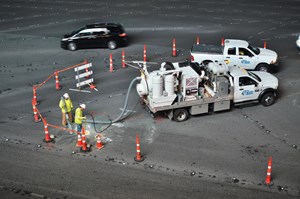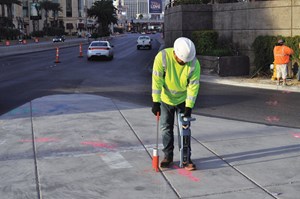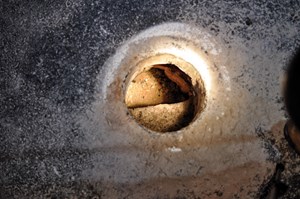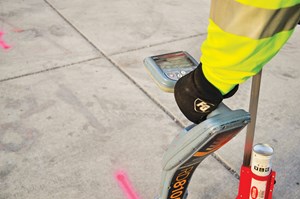May 2020 Vol. 75 No. 5
Features
Subsurface Utility Engineering Decade in Review: Prognostication of the Future
By James H. Anspach, PG(r), Dist.M.ASCE | ASCE UESI Past President
Since 1990, I have published a look at the evolution of SUE by the decade. This article is the third and probably final decade that I will look at, but hopefully someone will take up the challenge in 2030. The publications from 1990–2000 and 2000–2010 are included for reference at the end of this article. The publication from 1980–1990 was pre-internet and lost to me, but I think appeared in the former magazine Underground Focus.
Much has happened in the subsurface utility engineering (SUE) industry this past decade. There has been a steady and increasing rate of acceptance, practice improvements through research and education, and industry growth.
ASCE 38 served as the basis for international, country-specific standards by Australia (AS-5488 in 2013), the United Kingdom (PAS 128 in 2014), and Ecuador (NTE INEN 2873 in 2015). Canada published CSA S250-11 in 2011, which referenced ASCE 38 for documenting existing utilities, but added in requirements for documenting newly installed or exposed utilities via a mechanism of a Utility Accuracy Level.
ASCE worked with CSA and others over this past decade to get a new U.S. Standard, Standard Guideline for Documenting and Exchanging Utility Infrastructure Data, to fruition. This “Utility As-Installed” standard is now in the public comment period.
Research projects performed prior to 2010 (SHRP2 R01 and R15) were funded for technology transfer implementation. That implementation happened, with about 15 states’ Departments of Transportation (DOTs) participating. Although not every project was a success, most did change the way utilities were handled in the states.
Multi-channel ground penetrating radar (GPR) and utility conflict matrices and management are becoming a standard of practice on larger projects as a result of the research and implementation demonstrations. In 2018, FHWA issued a Program Review of Utilities with strong statements on the need for increased use of SUE and better utility coordination processes in order to comply with federal regulations. The FHWA also rolled out a massive educational program called Every Day Counts, in which 3D utility investigations and models were highlighted as the future of larger highway projects.
In 2015, ASCE commissioned its ninth institute, the Utility Engineering and Surveying Institute, as recognition that utilities and engineering survey, are vital functions of the civil engineer. This move by ASCE had significant ramifications by mainstreaming utility engineering (UE) as a branch of civil engineering practice. As a result, the definition of SUE was modified to better fit under the umbrella of UE.
Utility engineering is defined as a branch of civil engineering that focuses on the plan, position, design, construction, operation, maintenance and asset management of any and all utility systems, as well as the interaction between utility infrastructure and other civil infrastructure. SUE is redefined as the specialty practice of civil engineering’s utility engineering branch that includes the investigation, analysis, judgment and documentation of existing utility networks.
The Transportation Research Board published its six pillars of utility engineering at its 98th Annual Meeting. These six pillars are utility process management, utility investigations, utility conflict management, utility design, utility construction management and utility asset management. The Engineers Joint Contract Documents Committee, controlled by ASCE, ACEC and NSPE, and assisted by more than 20 other organizations such as APWA, in 2014 recognized ASCE 38 as a “basic engineering service” in its standard contract documents.
In 2018, EJCDC added utility coordination to that recognition. The Transportation Association of Canada published its document, “Guideline for the Coordination of Utility Relocations,” in 2016.
Schools and bills
In 2016, the inaugural Utility Investigation School for SUE Professionals, a 40-hour short course, was held at Louisiana Tech’s Trenchless Technology Center. Now on its seventh school and held at other universities in addition to LaTech, more than 200 professionals have completed the course and test.
Universities are beginning to understand the demand and necessity for education in utility issues in their curricula. The University of Texas-Arlington initiated a Utility Engineering Masters Program in 2019. Several other universities are in discussions to do the same. Colorado School of Mines holds an annual 90-minute class for its third-year civil engineering students in utilities. The University of Florida holds a similar session for its geomatics students. Universities across the country are looking at adding courses specific to utility engineering.
In 2017, the development and passage of Colorado Senate Bill 167, required significant projects attempt to achieve Utility Quality Level B and A data on known and undocumented utilities within the project limits. It is the first One-Call Design Ticket language that has responsibility for negligent errors or omissions in performing utility investigations and sealing the results on deliverables. Pennsylvania law also references the use of ASCE 38 and SUE on certain projects but is not as prescriptive.
ASCE elected its first Distinguished Member to honor a professional practicing in the field of Utility Engineering in 2018. That year also saw the formation of the Subsurface Utility Engineering Association. It is intended to complement other trade associations or professional societies, and fill a void by specifically focusing on companies within SUE practice, recognition of ASCE Standard 38-02, SUE education, advocacy, certification and best practices.
The California State Board for Professional Engineers, Land Surveyors and Geologists ruled that the use and interpretation of GPR for depiction of utilities on public projects requires a licensed California professional. This ruling supports the historical practice of SUE as a team of engineers, engineering surveyors and geologists.
Proof of ability to perform SUE has always been vague. To support better decision making on that front, and to support better SUE scopes of work, ASCE published Subsurface Utility Engineering for Municipalities (sic. Public Agencies): A Prequalification and Scope of Work Guide in 2019.
The long-awaited update to ASCE 38 is in an editor’s hands for committee balloting. There will be many new and improved items reflecting all the lessons learned over the past two decades, including much of what is mentioned in this article about the progress from 2010 to 2020. To accompany this new edition, a Board Accreditation program is in development at ASCE to provide certifications for a Utility Investigation Professional, a Project Utility Conflict Manager and a Subsurface Utility Designator.
Decade summary
To recap this decade, we have a home for individuals practicing in the realm of SUE (UESI), a home for companies practicing in the field of SUE (SUE Association), and a standard suite of engineering contracts stating SUE and UE are basic services on projects. In addition, there is a prequalification guide for SUE consultants, a scope of work checklist for SUE, 3D models, new geophysical tools, a recognition that SUE requires a team of disciplines, a national Utility As-Built standard, an updated ASCE 38, and a prescriptive statute in one state requiring the use of ASCE 38 on projects.
All elements are in place for continued growth of SUE and UE in the decade to come, although it comes with a price. There will always be forces that will try to make a dollar over protecting the public. There will always be persons and professions that feel “left out” and believe they are owed a piece of the pie even though they are not willing to work for it, contribute to the knowledge base, or lead with actions instead of complaints.
Everyone is urged to join in and contribute to the furtherance of Dependable Efficient Engineering Practices (DEEP). That acronym was an integral part of the values of So-Deep, which developed this practice of SUE in 1981. Those values still hold today, even though So-Deep has long gone the way of mergers and acquisitions, as our industry undergoes necessary change.
Design firms will have in-house specialists trained and certified in utility conflict management. ASCE 38 utility investigations will be specified more, with increased use of multi-channel GPR. 3D modeling of utilities will become more common, although the “z” value will need to have its uncertainty visualized somehow. Rights of Way managers and permitting agencies will start requiring removal of abandoned facilities during excavation exposures.
There will be more state One-Call design ticket provisions similar to Colorado’s statute. Utilities will be incorporated into most civil and construction engineering curricula. Clients will increasingly hold their SUE sub-consultants accountable for negligent errors and omissions.
Who will make it happen? •
All photos courtesy of T2 Utility Engineers








Comments